If you’ve ever struggled to find your shoes in a cluttered closet, noticed unpleasant odors, or discovered your favorite pair misshapen, you already know why proper storage matters.
As a nurse, you have to stand on your feet for a long time regularly. Your shoes take a tough beating all day long. As you take care of your feet, it’s also important for you to take care of your daily companion, your shoes.
Learning how to store shoes properly keeps them clean, fresh, and ready to wear—while also helping you save space. For nurses who rotate between work shoes and casual footwear, smart storage habits can make all the difference.
Why Storing Shoes Properly Matters
Shoes take a beating every day—from sweat and dirt to exposure to moisture. So, they need a proper cleaning regularly. But it’s not enough to just know how to clean them. If you don’t store shoes properly, they start showing signs of wear and tear.
And before you know it, they become unusable. Proper shoe storage isn’t just about keeping your closet tidy; it’s essential for maintaining the health, hygiene, and longevity of your footwear.
- Prevents Odor and Bacteria Growth:
When shoes are left in damp or poorly ventilated areas, they become a breeding ground for bacteria and fungi. This leads to unpleasant odors, mildew, and even potential foot infections. Storing shoes in a dry, breathable environment allows moisture to evaporate, reducing the risk of microbial buildup and keeping your shoes—and feet—fresh.
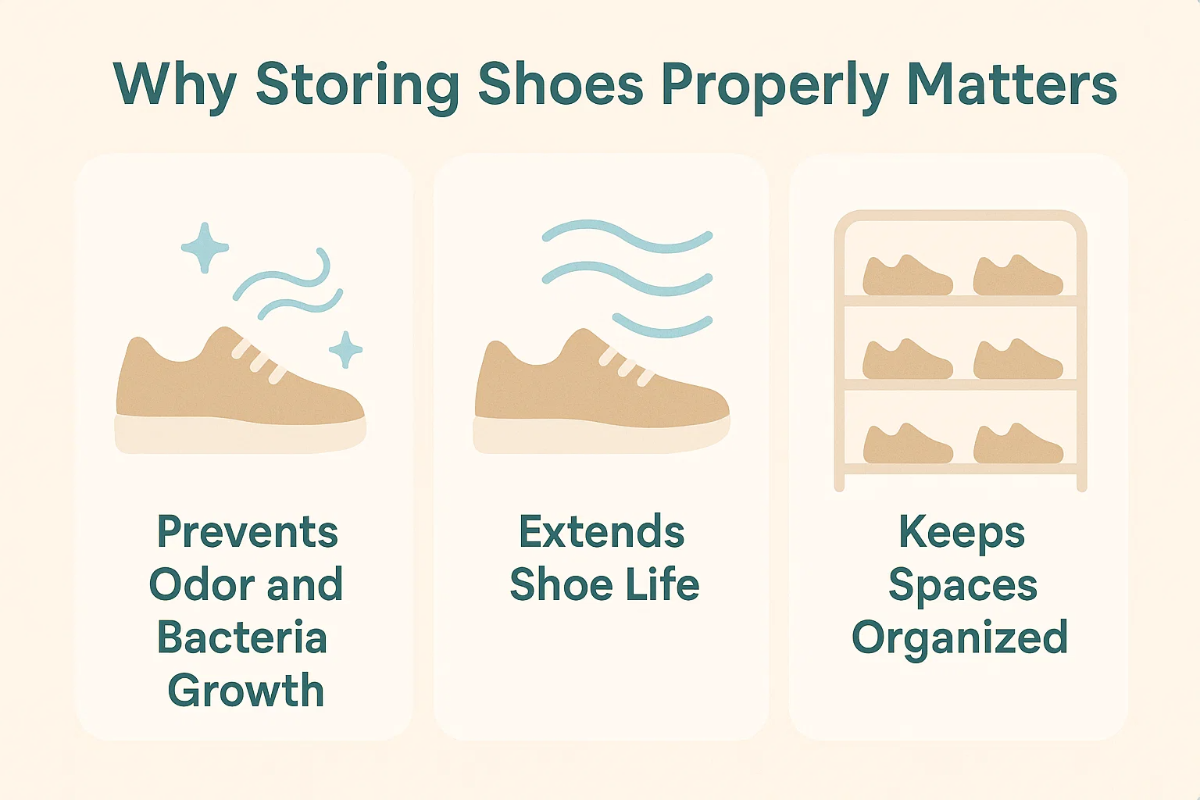
- Extends Shoe Life:
Shoes can lose their shape if they’re carelessly piled up or crushed in tight spaces. This causes creases in the material, warped soles, and overall damage that shortens the lifespan of your footwear. Using supportive storage methods like shoe trees, stackable bins, or dedicated racks helps shoes maintain their structure, ensuring you get the most wear possible from each pair.
- Keeps Spaces Organized:
For nurses or anyone living in smaller spaces like dorms or shared apartments, organized shoe storage is a game-changer. Efficient storage solutions free up room, reduce clutter, and make it easier to find the pair you need quickly. This is especially important when managing multiple pairs, such as work shoes, casual sneakers, and dress footwear.
How to Store Shoes Properly: Expert Tips to Organize Your Shoes
Many of you may think that, you don’t need to store shoes properly. Just keep them anywhere in the room and that’s it. But storing shoes properly isn’t that confusing, just a few simple steps and you’re done. For thst you just need to follow some simple steps.
1. Best Way to Store Shoes Properly in a Small Space
When you’re dealing with limited storage space, especially in small apartments, dorms, or nurse housing, making the most of every inch is essential. The key is to think vertically and use every nook and cranny cleverly so your shoes stay accessible yet out of the way.
Vertical Racks or Tiered Shelving:
One of the smartest ways to save floor space is by going vertical. Vertical shoe racks or tiered shelves allow you to store multiple pairs stacked neatly without crowding your room. These racks can fit into corners or closets, keeping your shoes visible and easy to grab without creating clutter.
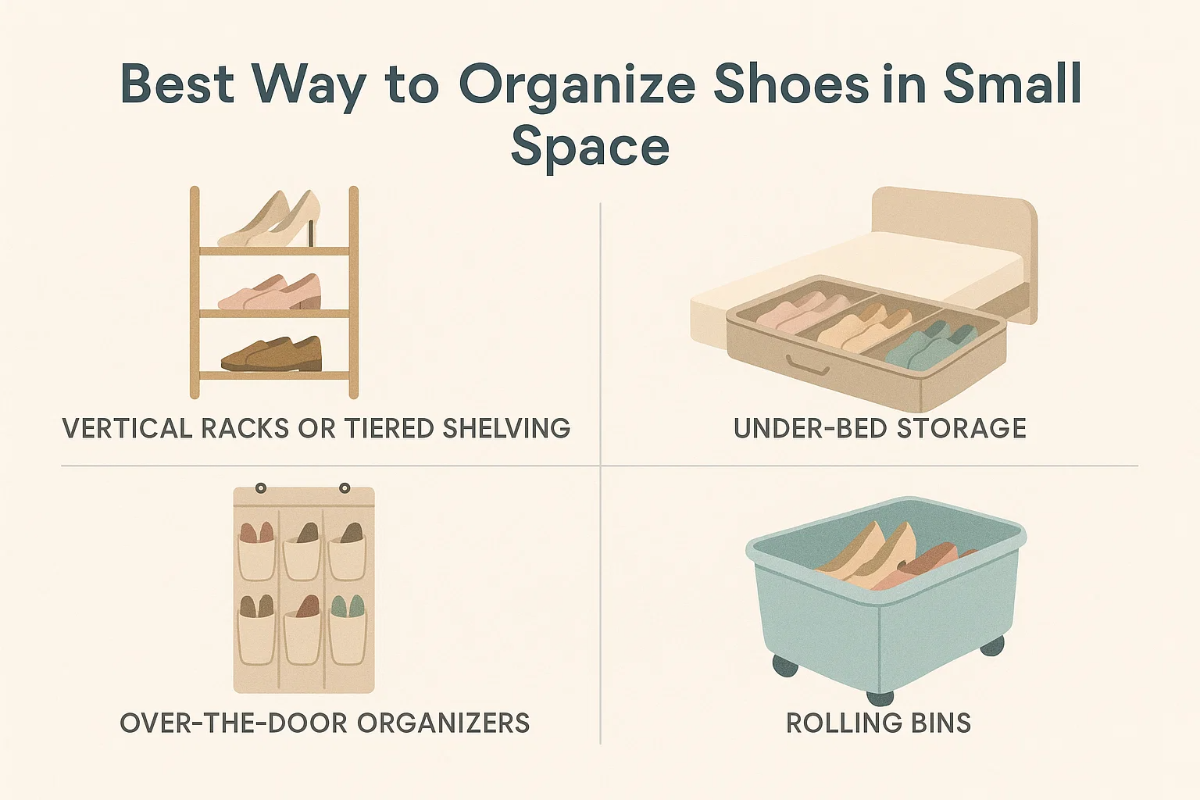
Under-Bed Storage:
The space under your bed is often underutilized but perfect for shoe storage. Using breathable bins or containers, you can slide shoes out of sight while keeping them organized and protected from dust. This method works especially well for pairs you don’t wear daily, like seasonal shoes or special-occasion footwear.
Over-the-Door Organizers:
If floor and closet space are tight, an over-the-door shoe organizer can be a lifesaver. These hangers with pockets or shelves are ideal for lightweight shoes like sandals, flats, or sneakers, and they free up precious space while keeping your shoes easy to access.
Rolling Bins:
For those who like to rotate their shoes based on season or outfit, rolling bins offer a practical and mobile storage solution. You can tuck these bins under furniture or in closets and easily pull them out when it’s time to switch up your footwear.
Using these strategies, you can keep your shoe collection organized, easy to find, and well-preserved, even in the smallest spaces.
2. How to Store Shoes Properly in a Closet
Nursing shoes go through a lot every day—from long shifts on hospital floors to exposure to various environments. Because of this, they require special care when it comes to storage. Keeping them in good condition not only extends their life but also helps maintain hygiene and comfort.
Keep Them Accessible:
Since nursing shoes are a daily essential, it’s helpful to keep them within easy reach. If you want to store shoes properly in a closet, you have to make sure they are easily accessible first.
Placing your work shoes at the front of your closet or on a designated shelf means you won’t have to hunt for them during busy mornings or shift changes. This quick grab-and-go setup saves time and helps keep your routine smooth.
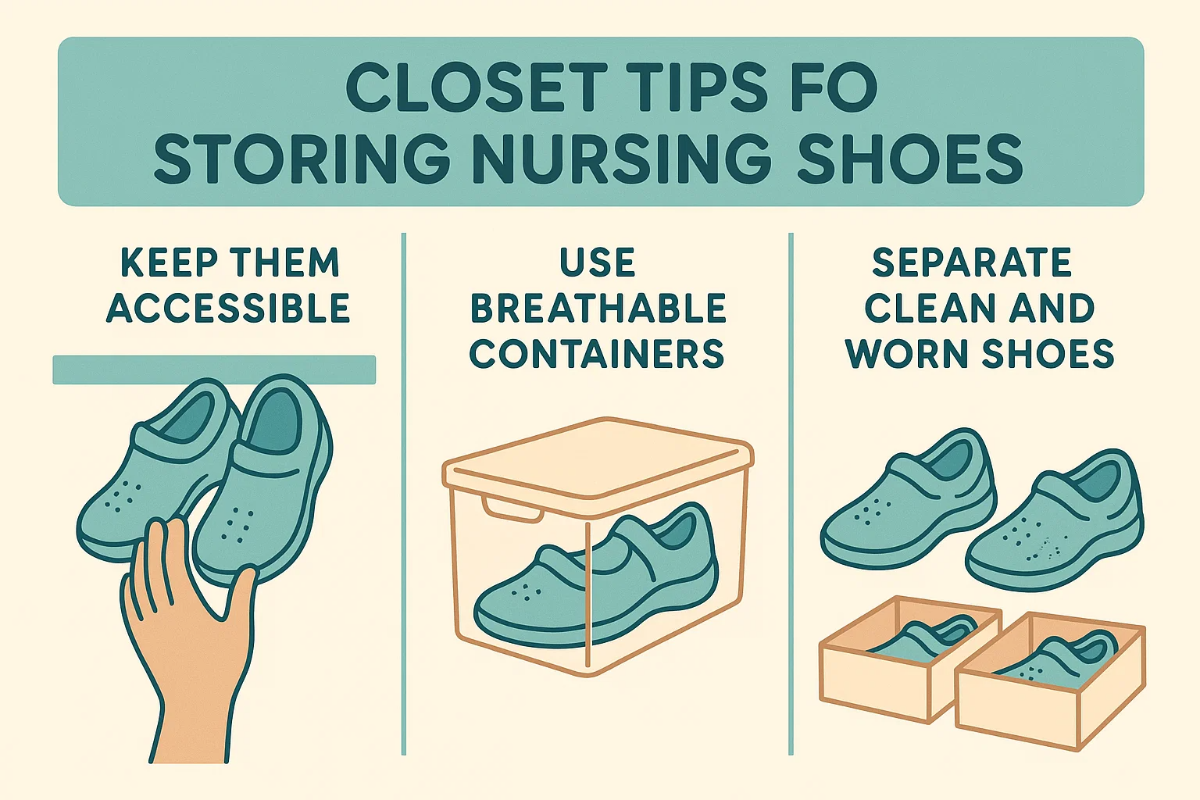
Use Breathable Containers:
To protect your nursing shoes from dust while allowing them to breathe, opt for breathable storage options like mesh bins or fabric boxes. These containers prevent moisture buildup and allow air circulation, reducing the risk of odor and bacterial growth. Avoid airtight plastic boxes that trap moisture, especially if your shoes tend to get sweaty during shifts.
Separate Clean and Worn Shoes:
Hygiene is critical in healthcare settings. To avoid cross-contamination, always store freshly cleaned nursing shoes separately from those you’ve recently worn. You might use separate shelves or bins, or even a simple shoe rack with distinct sections. This practice helps keep your work shoes sanitary and ready for your next shift.
3. How to Store Shoes Properly to Keep Them Dust-Free
Dust might seem harmless, but over time, it can dull your shoes’ appearance and even harm delicate materials like leather or suede. Keeping your shoes dust-free not only preserves their look but also helps maintain their quality and longevity.
Use Clear Shoe Boxes:
Clear shoe boxes are a smart choice because they let you see what’s inside without having to open them, making it easier to find the pair you want quickly. These boxes create a protective barrier against dust while keeping your shoes neatly organized.
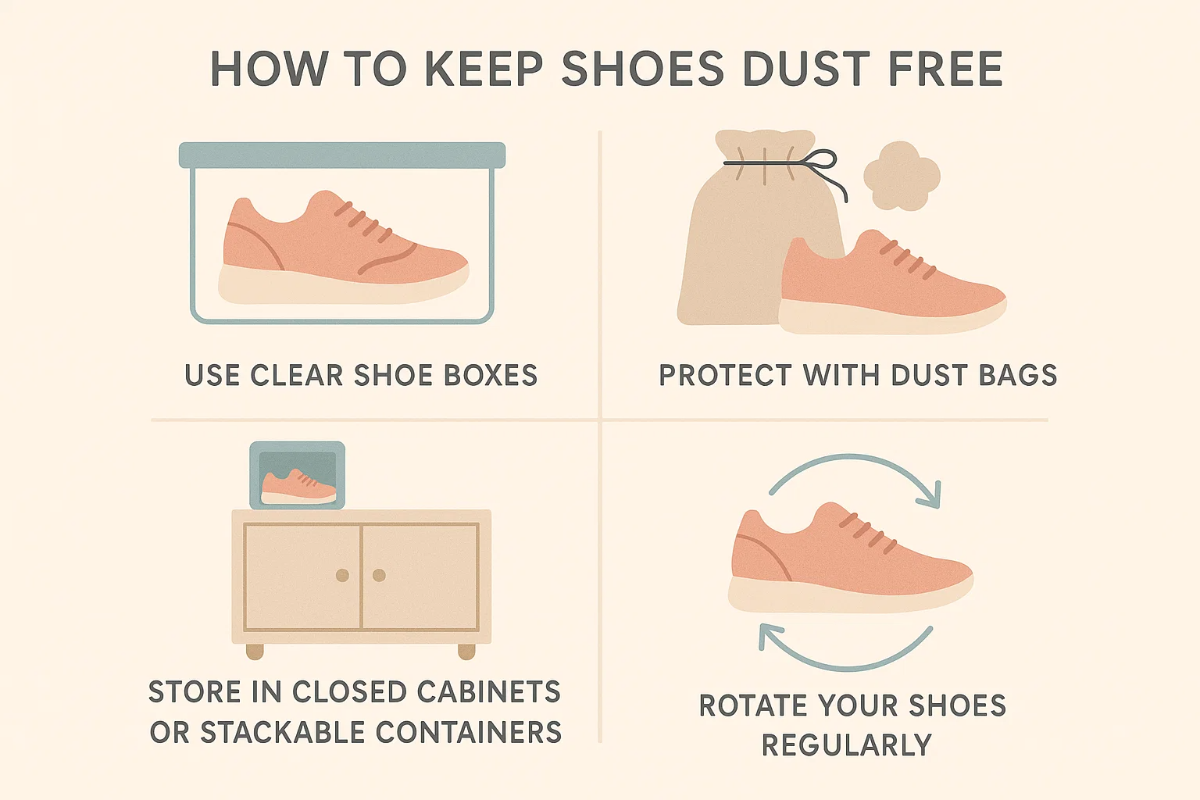
Protect with Dust Bags
For shoes made of sensitive materials like leather or suede, dust bags are an excellent solution. These soft fabric bags shield your shoes from dust and scratches without trapping moisture, helping your shoes stay in pristine condition.
Store in Closed Cabinets or Stackable Containers
If you have limited space, closed cabinets or stackable containers offer a neat way to protect your shoes while maximizing storage. These enclosed spaces keep dust at bay and allow you to stack multiple pairs safely, keeping your closet tidy.
Rotate Your Shoes Regularly
Wearing your shoes regularly prevents them from sitting idle long enough to gather dust. Rotation not only keeps your footwear cleaner but also allows air to circulate around each pair, reducing the chance of buildup and odor.
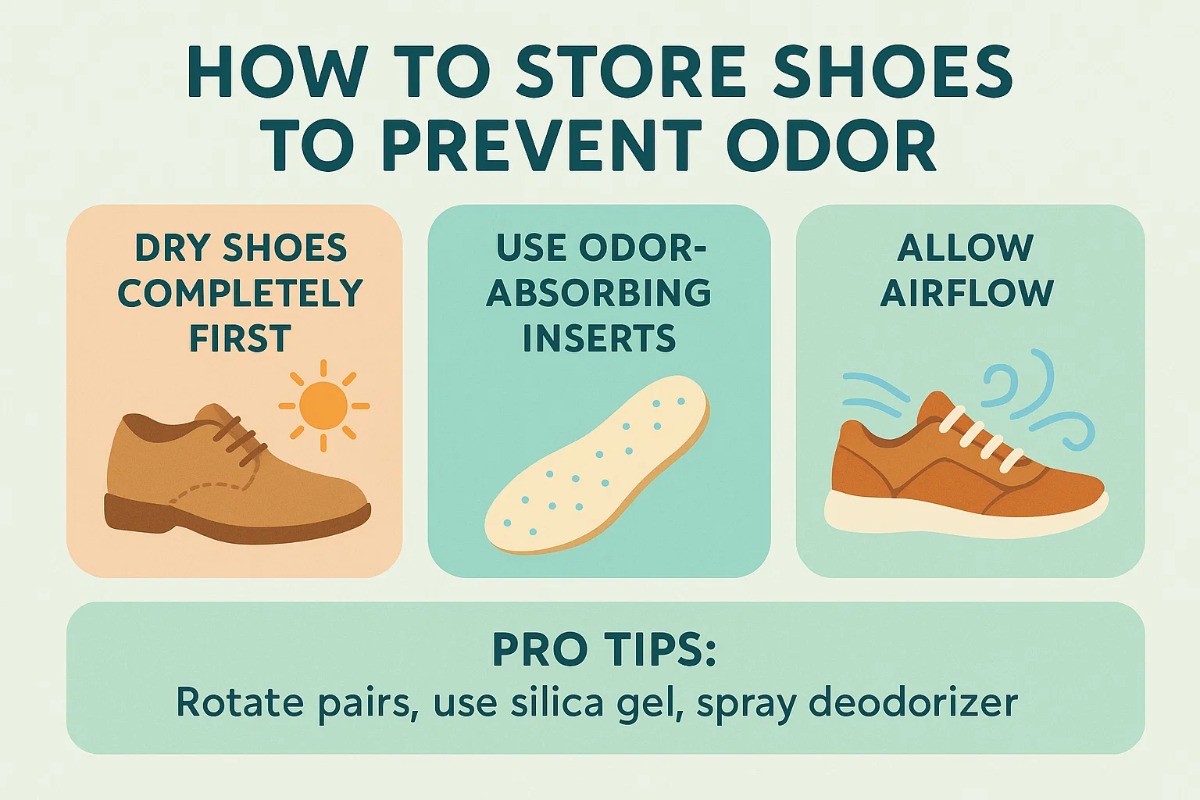
4. How to Store Shoes Properly to Prevent Odor
One of the biggest challenges in shoe storage is preventing unpleasant odors caused by moisture and sweat. Proper storage not only keeps your shoes smelling fresh but also helps maintain their material and overall condition.
Dry Shoes Completely First:
Before storing, make sure your shoes are completely dry. Moisture trapped inside can breed bacteria and fungi, leading to strong odors and even damage. To prevent this, you need to dry your shoes first. To dry your shoes, you can use a shoe dryer or stuff them with crumpled newspaper overnight to absorb excess moisture.
Use Odor-Absorbing Inserts:
Incorporate odor-absorbing inserts like cedar shoe trees, activated charcoal bags, or homemade baking soda sachets. These natural deodorizers neutralize smells and keep your shoes fresh over time.
Allow Airflow:
Avoid placing damp or sweaty shoes in airtight containers, as this traps moisture and worsens odor. Instead, opt for breathable storage options like mesh bags, ventilated boxes, or open shelving to encourage airflow.
Pro Tips:
- Rotate your shoe pairs regularly to let each pair air out between uses.
- Use silica gel packets inside your shoe boxes to absorb any lingering moisture.
- Consider spraying shoes with a fabric-safe deodorizer before storing, especially after a long shift.
5. How to Stack Shoes Without Damaging Them
Sometimes limited space means stacking shoes is unavoidable. But doing it the wrong way can lead to crushed soles, misshapen uppers, and damaged materials. Follow these tips to stack your shoes safely and extend their lifespan.
Use Shoe Stackers or Shelf Dividers
Invest in shoe stackers or shelf dividers designed to keep each pair separate and evenly supported. These tools prevent shoes from being squished under the weight of others and help maintain their shape.
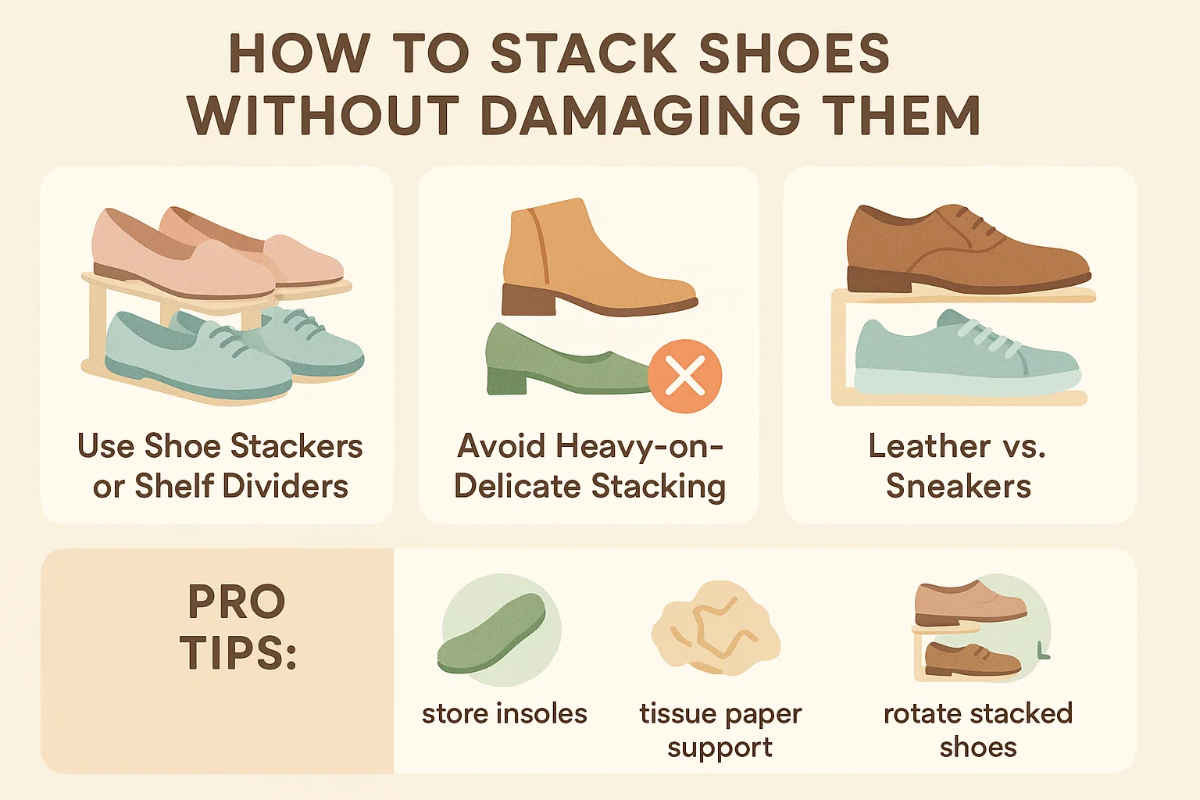
Avoid Heavy-on-Delicate Stacking
Be mindful of which shoes go on top. Avoid placing heavy boots, heels, or work shoes on top of delicate flats, sneakers, or soft leather shoes. The pressure can deform the lighter shoes and cause creases or damage.
Leather vs. Sneakers
Leather shoes need space to breathe and shouldn’t be tightly stacked. Keep them in breathable containers or give them their own shelf space. Sneakers, made of more durable and flexible materials, can usually handle light stacking, but still avoid crushing.
Pro Tips:
- Store insoles separately or inside shoes to help maintain their shape.
- Place tissue paper inside leather shoes before stacking for added support.
- Rotate stacked shoes occasionally to prevent permanent pressure marks.
Recommended Products
Here are some must-have tools for proper shoe storage:
Products | |
Stackable Shoe Bins | |
Over the Door Shoe Organizers | |
Travel Shoe Bags | |
Odor Control Shoe Organizers |
Conclusion
Proper shoe storage goes beyond just tidying up your closet — it’s essential for keeping your footwear clean, odor-free, and long-lasting. By regularly cleaning and thoroughly drying your shoes before storing them, you prevent damage from moisture and odors.
Using smart organizing solutions like vertical racks, breathable containers, and careful stacking helps you make the most of limited space while protecting your shoes from deformation and dirt.
Whether you’re juggling daily nursing shoes and casual sneakers or managing a small closet, adopting these storage habits will keep your footwear fresh, comfortable, and ready for every step. Taking these small but intentional steps today will save you time, money, and frustration in the long run—because healthy shoes mean happy feet.
FAQs: Answering Common Doubts about Storing Shoes Properly
What is the best way to store shoes to prevent smell?
Always store them dry, use odor-absorbing inserts, and allow airflow.
How can I store shoes if I have limited closet space?
Use vertical racks, under-bed bins, or over-the-door organizers.
Should I use plastic boxes or fabric bags for storing shoes?
Plastic boxes protect from dust, while fabric bags are better for delicate materials.
How do I store shoes I don’t wear often?
Clean thoroughly, place in dust bags or boxes, and store in a cool, dry area.
How do I prevent shoes from losing shape in storage?
Use shoe trees or stuff them with tissue paper to maintain form.

Leave a Reply